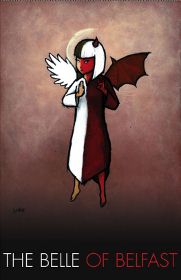THE ’˜TROUBLES’ WITH FAITH
Choosing to write about the Irish Troubles comes with baggage’”many people have come before you, and many will come after. Like the Holocaust, it can conjure a deep vein of feeling, but the idea of slogging through it again can also seem like a chore to audiences. It takes skill, flair, and inspired energy to overcome the potential for jadedness. The Belle of Belfast playwright Nate Rufus Edelman is largely up to the task; he has a lot on his mind, and he has the good fortune to be in the hands of the creative team at the Ensemble Studio Theatre/LA, who are giving his work lovingly detailed attention.
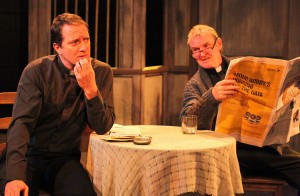 It’s 1985 in Belfast’”the city at the center of the Catholic/Protestant war over a united Ireland. A badass, emotionally volatile seventeen year-old orphan girl gets involved with a well-meaning Catholic priest, who doesn’t at first realize the depth of his own unhappiness. There is death, religious bigotry, family violence, sexual misadventure, alcoholism, some lovely singing, and a bittersweet aura of regret. Familiar territory in some ways, but Edelman’s way of circling around the characters’ manipulations’”of one another, and of their own notions of themselves’”is sharp and well-observed.
It’s 1985 in Belfast’”the city at the center of the Catholic/Protestant war over a united Ireland. A badass, emotionally volatile seventeen year-old orphan girl gets involved with a well-meaning Catholic priest, who doesn’t at first realize the depth of his own unhappiness. There is death, religious bigotry, family violence, sexual misadventure, alcoholism, some lovely singing, and a bittersweet aura of regret. Familiar territory in some ways, but Edelman’s way of circling around the characters’ manipulations’”of one another, and of their own notions of themselves’”is sharp and well-observed.
Sarah Gise plays Anne Malloy, a rebellious child of parents killed as collateral damage in an IRA bombing that resulted in seven Protestant fatalities. Gise looks a bit older than seventeen, and her Northern Irish accent is a little wobbly occasionally, but she is quite persuasive in the role. She scrunches up her face with frustration and hope, a termagant looking for some way, any way, to express her fury. She hates, hates, hates her drunken busybody of a great-aunt, wittily played by Carol Locatell, who goes to confession to confess the sins of others, having none of any consequence she’s willing to recognize in her own judgmental, gossipy behavior.
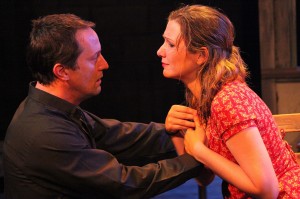 The youngish Father Reilly is patient and concerned, but a trifle distant. Daniel Blinkoff plays him as a man who is thoughtful and methodically careful’”about any appearance of impropriety and about the possibility of his actions being misunderstood. He is not seduced by Anne’s sexual come-ons so much as by her pain. She is tortured by the fact that her parents are considered martyrs yet she finds their deaths so pointlessly awful. For her there is no nobility in suffering, just despair and loss. Blinkoff is forced to confront his own part in contributing to the exaltation of Catholic-on-Protestant violence; and it is this realization that leads him into her arms. (Though she does have a smokin’ hot bod’¦)
The youngish Father Reilly is patient and concerned, but a trifle distant. Daniel Blinkoff plays him as a man who is thoughtful and methodically careful’”about any appearance of impropriety and about the possibility of his actions being misunderstood. He is not seduced by Anne’s sexual come-ons so much as by her pain. She is tortured by the fact that her parents are considered martyrs yet she finds their deaths so pointlessly awful. For her there is no nobility in suffering, just despair and loss. Blinkoff is forced to confront his own part in contributing to the exaltation of Catholic-on-Protestant violence; and it is this realization that leads him into her arms. (Though she does have a smokin’ hot bod’¦)
Father Reilly is talked into a kind of repentance by his superior, a magnificent wreck of a priest played by Billy Meleady, an actor who absolutely nails’”not just the drunkenness’”but the alcoholic shakiness that could soon lead to convulsions without another shot of booze. There is one more character in the mix, a friend of Anne’s (Caitlin Gallogly) who feigns a love of misbehavior, but turns out to be much more straight-laced in her views on sex between parishioners and priests. Gallogly is fresh, believable, and very sympathetic. She gives us a look at what Anne might have been like had her parents lived, and had she felt loved by someone.
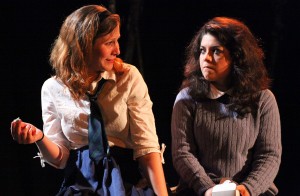 The writing is often quite funny: Anne is described as having “a mouth on her that could make a Dublin junkie blush,” and the priests wonder whether they will still be priests in heaven, which would make heaven a kind of hell. Edelman’s dialogue also has a yearning, earnest quality that can be very moving. “I used to be a happy girl, but what do I have to look forward to?” Anne asks Father Riley, when he insists that she can find happiness in her future, and the simplicity of the question is allowed to resonate. This is a girl with absolutely nothing to be happy about, and she has no blue horizon beckoning.
The writing is often quite funny: Anne is described as having “a mouth on her that could make a Dublin junkie blush,” and the priests wonder whether they will still be priests in heaven, which would make heaven a kind of hell. Edelman’s dialogue also has a yearning, earnest quality that can be very moving. “I used to be a happy girl, but what do I have to look forward to?” Anne asks Father Riley, when he insists that she can find happiness in her future, and the simplicity of the question is allowed to resonate. This is a girl with absolutely nothing to be happy about, and she has no blue horizon beckoning.
The religious struggles at the heart of the story are less well realized. All of the characters make repeated references to the pedophile scandals bedeviling the Catholic Church, but these issues had not yet come to light in Belfast in 1985, nor were they topics of everyday conversation even into the early years of the twenty-first century. And Father Reilly’s dilemma about his own culpability in spreading the glorification of violence’”while fascinating’”is under-dramatized.
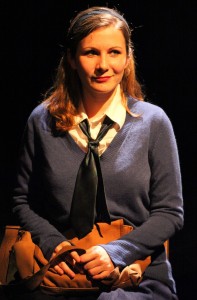 Claudia Weill directs with delicacy and authenticity. She finds a rhythm that keeps the pace moving, but also allows the actors time for some of their big moments to settle. (Anne and Reilly’s first kiss is a marvel of assured patience and timing.)
Claudia Weill directs with delicacy and authenticity. She finds a rhythm that keeps the pace moving, but also allows the actors time for some of their big moments to settle. (Anne and Reilly’s first kiss is a marvel of assured patience and timing.)
The more abstract elements of Hana S. Kim’s set are inventive and gorgeous’”there are projections of a church, of barbed wire, and there are platforms and walkways that are well calibrated and well used. From a naturalistic perspective however, the set is something of a let-down; the church residence of the two priest’s, for example, is dreary without evoking any particular feeling.
Pablo Santiago’s lighting is absolutely inspired. He seems able to pinpoint feeling and movement’”giving the impression of a close-up here, a medium shot there, and a whole world with the blink of an eye. Dianne Graebner’s costumes are just right.
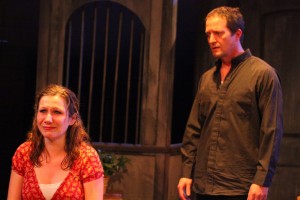 There were problems on opening night with sound cue misfires and level issues, leaving Joseph “Sloe” Slawinski’s sound design out on a limb. And while we’re on the issue of sound’¦ I appreciate Ensemble Studio Theatre/LA’s ambitious multi-theater production plans, but the loud rock and roll bleeding through from the theater next door came close to ruining one of the most important moments of The Belle of Belfast. Soundproof the theaters. Please.
There were problems on opening night with sound cue misfires and level issues, leaving Joseph “Sloe” Slawinski’s sound design out on a limb. And while we’re on the issue of sound’¦ I appreciate Ensemble Studio Theatre/LA’s ambitious multi-theater production plans, but the loud rock and roll bleeding through from the theater next door came close to ruining one of the most important moments of The Belle of Belfast. Soundproof the theaters. Please.
This play deserves to be heard’”fully. Near the end, after a separation, Anne asks Reilly how he’s feeling. He tells her he’s doing fine, but his whole being screams a very different truth. He is totally alone. And so is she.
photos by Betsy Newman
The Belle of Belfast
Ensemble Studio Theatre/LA at the Atwater Village Theatre in Glendale
scheduled to end on October 28, 2012
for tickets, visit EST/LA http://www.ensemblestudiotheatrela.org/boxoffice.html]
